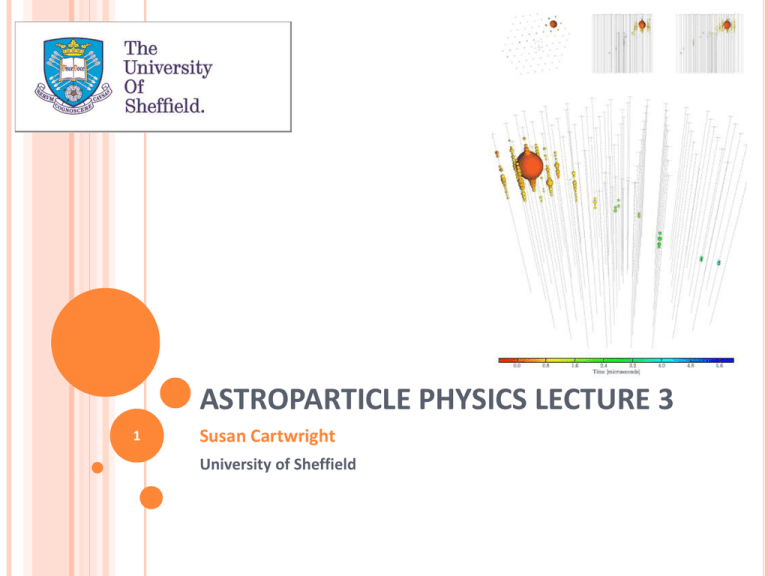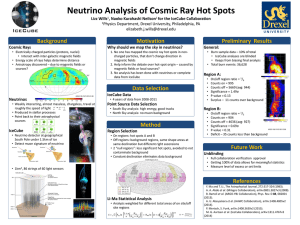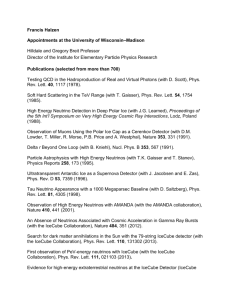ASTROPARTICLE PHYSICS LECTURE 3 Susan Cartwright University of Sheffield 1
advertisement

ASTROPARTICLE PHYSICS LECTURE 3 1 Susan Cartwright University of Sheffield HIGH ENERGY ASTROPARTICLE PHYSICS 2 Acceleration Mechanisms Sources Detection ν NEUTRINO DETECTION Neutrino cross-section rises with energy Only UHE neutrinos (>1015 eV or so) interact with reasonably high probability (such that Earth is opaque to them) Connolly, Thorne & Waters, hep-ph/1102.0691v1 ν 3 NEUTRINO DETECTION (PENETRATING NEUTRINOS) Mostly rely on detecting the charged lepton produced in CC interactions at lowest energies (solar neutrinos), also elastic scattering (ν + e → ν + e) and NC reaction on deuterium (ν + d → ν + p + n) note that at solar neutrino energies μ and τ cannot be produced by CC, so νμ, ντ only seen in NC (e.g. SNO) Some early experiments using tracking calorimeters, but water Cherenkovs now standard practice can obtain large effective volumes by instrumenting natural bodies of water/ice particle identification by ring morphology at low energies, shower shape at high energies 4 NEUTRINO DETECTION BY WATER CHERENKOV Transparent medium (water/ice) PMTs Cherenkov light μ CC interaction νμ Effective volume increases with energy 5 BACKGROUNDS Cosmic ray muons Go deep Look down therefore, northern hemisphere telescope sees southern sky, and vice versa Atmospheric neutrinos one man’s signal is another’s background! irreducible, but steeper spectrum than high-energy astrophysical neutrinos 6 PARTICLE ID: SUPER-KAMIOKANDE muon: sharp ring electron: fuzzy ring 7 PARTICLE ID: ICECUBE νμ νe “double-bang” ντ event: initial signal from CC interaction, later one from τ decay 8 Halzen & Klein, Rev. Sci. Inst. 81 (2010) 081101 ντ HIGH-ENERGY NEUTRINO TELESCOPES 9 LAKE BAIKAL 1. Central core (NT200) with 96 pairs of OMs on 8 strings 2. Outer ring with 3 additional strings each equipped with 6 OM pairs 3. Lasers for calibration Each OM equipped with 37-cm PMT 10 ANTARES 2475 m deep, 42 km off Toulon 885 OMs arranged in triplets on 12 lines; each OM equipped with 10” PMT Acoustic transponders for position monitoring LED and laser optical beacons for calibration 11 ICECUBE Much the largest existing detector, instrumenting 1 km3 of Antarctic ice. Precursor, AMANDA II, very similar to ANTARES in size and sensitivity. 12 MEDIUM PROPERTIES Lake Baikal Mediterranean (ANTARES) Antarctic ice Absorption length (m) 20−24 50−70 (blue) ~100 Scattering length (m) 30−70 230−300 (blue) ~20 Depth 1370 2475 2450 Property Noise Retrieve/ redeploy Quiet Yes 40K, bioluminescence Yes Quiet No Long scattering length for ANTARES implies better angular resolution; long absorption length for IceCube implies sparser instrumentation. Quiet environments imply potentially useful data from singles rates. 13 BACKGROUND IN ANTARES Three components steady background of ~60 kHz from 40K slowly varying contribution from bioluminescence, probably bacterial short bursts of strong bioluminescence, probably from larger organisms Correlated within a single storey, but not over long distances minimal influence on tracking efficiency does probably preclude use of singles rate, e.g. for detection of low energy neutrinos from supernova 14 LIGHT TRANSMISSION IN ICECUBE Scattering is a consequence of dust layers in the ice—function of global climate, level of volcanic activity, etc. “Dust logger” measures reflected light from artificial light source just after drilling: measure scattering with few mm vertical resolution. Note additional contribution from bubbles at shallow depths (<1400 m); IceCube deployed below this level. 15 ANGULAR RESOLUTION Moon’s shadow in CR muons, measured by IceCube Expected IceCube angular resolution ~0.5° 16 EXPECTED FLUXES Expect high-energy astrophysical neutrinos to be produced in proton interaction cascades therefore, observed CR flux implies upper bound on neutrino flux (WaxmanBahcall bound: Phys. Rev. D59 (1998) 023002) argument goes as follows: from observed CR rate, deduce that the amount of energy emitted by astrophysical sources in the form of UHE CRs (1019 – 1021 eV) is of order 1037 J Mpc−3 yr−1. assume that CRs lose some fraction ε of their energy through pion photoproduction before escaping the source fraction of proton energy carried by neutrino produced in this way is about 5% independent of proton energy, so neutrino energy spectrum follows scaled-down version of proton spectrum resulting bound is Eν2φν < 2×10−8 GeV cm−2 s−1 sr−1 for 1014−1016 eV ν 17 RESULTS For 3 years of data-taking: 37 events above 100 TeV, on background of about 15 Flux at 100 TeV: (6.7±1.2)×10−18 GeV-1 s-1 sr-1 cm-2 Spectral index 2.50±0.09 No significant point sources or correlations with other data 18 RESULTS No neutrinos from GRBs No GZK neutrinos No point sources (combined IceCube/ANTARES analysis: largest significance 0.7σ) 19 Example IceCube events 20 TAU-NEUTRINO DETECTION BY AIR SHOWERS Earth-skimming ντ interacts in Earth’s crust to produce τ τ decay in atmosphere initiates characteristic air shower shower appears to be in early stage of development—typical horizontal shower is “old” searched for by Auger—no signal (PRD 79 (2009) 102001) 22 HIGH ENERGY ASTROPARTICLE PHYSICS 23 New Detection Techniques RADIO-FREQUENCY DETECTION OF AIR SHOWERS AND NEUTRINOS Geosynchrotron emission (10−100 MHz) synchrotron radiation from air-shower particles gyrating in Earth’s magnetic field advantages over fluorescence: disadvantages: very high duty cycle (only wiped out by thunderstorms) low attenuation (so, large effective area) interference (need radio-quiet sites) high threshold (1017 eV) Radio Cherenkov (Askaryan effect) (0.1−2 GHz) Cherenkov emission from neutrino-induced showers because of net negative charge initially neutral shower develops ~20% negative bias because of annihilation of e+ and additional e− from Compton scattering etc. requires dense, radio-transparent medium not air, not water 24 GEOSYNCHROTRON EMISSION Studies run in association with Auger and KASCADE CR ground arrays A declared key science goal of LOFAR Collaboration 25 LOFAR Low frequency radio array based in the Netherlands Mostly a radio astronomy facility, but good prospects for radio detection of UHECRs (see LOPES/KASCADE). Also good for gravitational wave follow-up (excellent wide-field coverage) 26 LOPES/KASCADE KASCADE: scintillator-based ground array LOPES (LOFAR PrototypE Station) initially 10, now 30, low-frequency RF antennas triggered by KASCADE “large event” trigger KASCADE reconstruction provides input to LOPES recon: core position of air shower its direction its size 27 LOPES/KASCADE First detection: January 2004 strong coherent radio signal coincident with KASCADE shower reconstruction location agreed with KASCADE to 0.5° Extensive data sample now accrued technique works well and suggests full LOFAR array should be excellent CR detector 28 LOFAR AS A COSMIC RAY DETECTOR Small scintillator-based airshower array (LORA) set up in LOFAR core plastic scintillator detectors from KASCADE, set up in 5 sets of 4 estimated energy resolution ~30%, angular resolution ~1% combined running with LOFAR Thoudam et al., astro-ph/1102.0946v1 29 AUGER/AERA Preliminary studies using a few radio antennas at the Auger site gave promising results Plan to instrument 20 km2 near Coihueco fluorescence telescope with 160 autonomous self-triggering radio antennas 5000 events/year expected, 1000 above 1018 eV 124 stations deployed so far 30 AUGER/AERA/AMIGA EVENT DETECTION Shower depth determination by AERA and fluorescence Event detected by all four Auger subdetectors 31 ASKARYAN EFFECT Effect demonstrated in sand(2000), rock salt (2004) and ice (2006) all done in laboratory at SLAC Applications to neutrino detection using the Moon as target GLUE (detectors are Goldstone RTs) NuMoon (Westerbork array; LOFAR) RESUN (EVLA) using ice as target FORTE (satellite observing Greenland ice sheet) RICE (co-deployed on AMANDA strings, viewing Antarctic ice) ANITA (balloon-borne over Antarctica, viewing Antarctic ice) 32 ASKARYAN EFFECT: ANITA 33 ASKARYAN EFFECT Jaeger et al., Astropart. Phys. 34 (2010) 293 ANITA observed UHECRs (geosynchrotron signal) Nobody saw neutrinos (sadly) 34 ACOUSTIC DETECTION (SHOWERING NEUTRINOS) UHE (>1 PeV) neutrinos interact fairly readily on entering dense medium (water) they will initiate shower this dumps energy in a thin cylinder (~20 m × 20 cm) resulting pressure pulse spreads out from this cylinder in thin “pancake” perpendicular to incoming neutrino direction produces characteristic bipolar acoustic pulse which can be detected by hydrophone array advantages extremely long attenuation length (several km) very large volume can in principle be instrumented with relatively small number of hydrophones hydrophone technology well established in underwater applications can use off-the-shelf hardware disadvantages the sea is a very noisy place identifying signal very challenging 35 PRINCIPLES 36 EXPERIMENTS ACORNE AMADEUS part of NEMO (NEutrino Mediterranean Observatory, not Neutrino Ettore Majorana Observatory!) SAUND-I and SAUND-II codeployed with Baikal-200 ONDE codeployed with ANTARES Lake Baikal UK feasibility study using military hydrophone array off Rona in Bahamas, originally using military array, now extended SPATS at South Pole, associated with IceCube 37 ACORNE MoD hydrophone array off NW coast of Scotland successful R&D project showing feasibility of technique array geometry not optimal (not designed for neutrinos!) Example of background source— dolphin clicks! 38 AMADEUS Acoustic storeys added to ANTARES strings R&D project comparing different hydrophones feasibility study for KM3NeT 39 SPATS Acoustic sensors on strings deployed in association with IceCube very good at detecting IceCube drilling and water storage activities! 40 ACOUSTIC DETECTION: SUMMARY Experiments so far are R&D projects/feasibility studies limits not competitive with radio at present Future strategy mostly co-deployment with large optical Cherenkovs improves high-energy sensitivity likely future direction: super-hybrid experiments with optical Cherenkov, acoustic and radio elements, plus air-shower array if appropriate most nearly realised at South Pole with IceCube/IceTop/RICE/SPATS 41 NEUTRINO DETECTION: SUMMARY High-energy neutrinos could provide information on acceleration processes in high-energy astrophysics GZK cut-off in cosmic rays dark matter (see next lecture) Detection still in infancy only IceCube probably large enough to collect statistics Various promising techniques water Cherenkov at lower energies radio and possibly acoustic at high end Hybrid experiments feasible at many sites 42





